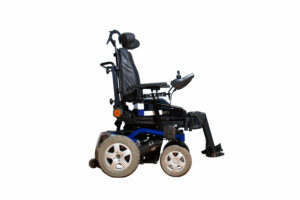 Enhancing Independence Through Power Wheelchair Seat Functions: A Case Study
Enhancing Independence Through Power Wheelchair Seat Functions: A Case Study
By Kirsten Davin, OTD, OTR/L, ATP, SMS
Restoring Mobility and Daily Function for a 92-Year-Old Client
Lucille, a 92-year-old woman, has faced increasing challenges in mobility and daily activities due to progressive weakness and declining health. A widow living independently in the home she shared with her late husband, she remains actively involved in her son’s farming operations and values her ability to cook, spend time with family, care for her dog, and handle household chores. However, her recent medical conditions have significantly limited her independence, making the need for a power wheelchair with advanced seat functions essential.
Medical Background and Functional Limitations
Lucille has multiple medical conditions, including diabetes, congestive heart failure, chronic pain due to osteoarthritis, and a stage 2 pressure injury on her right ischial tuberosity. Her history of bilateral knee replacements and a recent right shoulder replacement have further restricted her mobility. She also has macular degeneration, which limits her ability to read standard print but allows her to navigate her surroundings safely with large visual cues. Before receiving her power wheelchair, she could only walk about five steps with a wheeled walker, significantly restricting her independence.
The Power Wheelchair Solution
Lucille was provided with a front-wheel-drive power wheelchair equipped with power-adjustable seat height, tilt and recline functions, and elevating leg rests. These features helped her regain control over her daily activities and mobility.
Power Adjustable Seat Height
This function, also known as a power seat elevator, raises the seat without changing its angle, making transfers easier for individuals with weakness. For Lucille, this feature restored her ability to transfer independently, reach her refrigerator, prepare meals, do laundry, and—most importantly—watch her son and grandson work on farm equipment outside her kitchen window.
Power Elevating and Articulating Leg Rests
These leg rests allow users to adjust knee flexion and extension, which is particularly beneficial for those with chronic pain and limited mobility. Lucille required this function to manage her edema from congestive heart failure and to reposition herself comfortably. It also enabled her to achieve a reclined position without manual assistance, reducing discomfort and improving circulation.
Power Tilt
Lucille’s wheelchair included both posterior and anterior tilt functions. Posterior tilt allowed her to reposition herself and relieve pressure, preventing further skin injuries. Anterior tilt, combined with the seat elevator, assisted her in transitioning to a standing position, making transfers safer and more manageable.
Power Recline
Much like a traditional recliner, the power recline function adjusted the seat-to-back angle, offering Lucille comfort and pressure relief. This feature allowed her to reposition frequently, minimizing pain and reducing the risk of pressure sores.
Drive Wheel Considerations
Selecting the right drive wheel placement is crucial for wheelchair users. Since Lucille enjoys spending time outdoors and visiting family on the farm, a front-wheel-drive chair was chosen. This design offers better stability and navigation over uneven terrain, allowing her to continue engaging in the activities she loves.
Regaining Independence
Through the combination of power seat functions and a well-matched wheelchair base, Lucille successfully regained her independence. She is now able to perform daily tasks, visit with family, and continue enjoying her outdoor surroundings with ease. This case highlights the transformative impact of power wheelchair features in enhancing mobility, safety, and quality of life for individuals facing mobility challenges.
Understanding Wheelchair Cushions: A Guide to Support Surface Materials
By Caitlin Boland, PT, DPT, NCS, CBIS
Selecting the right wheelchair cushion is essential for user comfort, stability, and skin protection. Here’s a breakdown of common materials and their benefits:
Foam Cushions
- Available in open-cell and closed-cell varieties.
- Open-cell foams offer ventilation but can absorb fluids, requiring more maintenance.
- Viscoelastic foams provide better pressure distribution and temperature control.
- Softer foams may compress too quickly, increasing pressure on bony areas and raising the risk of skin breakdown.
Elastomer Cushions
- Made of polymer honeycomb structures, offering lightweight support.
- Contoured designs enhance comfort and stability.
- Easy to clean and maintain.
Fluid Cushions
- Adjust pressure distribution by shifting fluid within compartments.
- Reduce shear forces and provide skin protection.
- Require occasional kneading to maintain effectiveness.
- May be heavy and sensitive to extreme temperatures.
Gel Cushions
- Made of silicone or PVC, providing effective shear reduction.
- Easy to clean but can increase skin temperature due to lack of airflow.
- Tend to be heavier than other materials.
Air Cushions
- Comprised of sealed air compartments that adjust pressure dynamically.
- Lightweight and highly adaptable for immersion.
- Require careful maintenance to prevent punctures and ensure proper inflation.
- May reduce stability, affecting balance and function.
Selecting the Right Cushion
Understanding the unique needs of each wheelchair user is crucial when choosing a cushion. By carefully considering comfort, pressure relief, and stability, medical professionals can help users prevent skin breakdown and improve overall quality of life.
Original Article Found Here: https://rehabpub.com/seating-positioning/freeing-effects-of-seating-functionality/?utm_term=RM%20Rehab%20Today%20Mar%202025&utm_campaign_type=newsletter&utm_hsid=415264501&utm_medium=email&_hsenc=p2ANqtz-9lSDPmHVpRQek62M_fvpBDbsFElBotD1oE2_4bwSD8_py3Q2Hlky7C2iG0svVcUCeY1xQqdYNTVWImRq8WTKwTV7bK8A&_hsmi=353360751&utm_source=newsletter

Leave a Reply